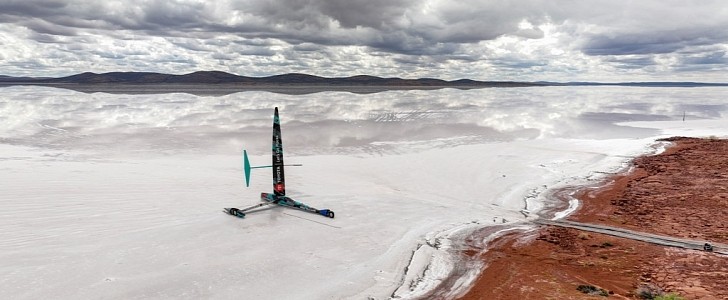It’s a funny-looking type of vehicle, but with huge ambitions. Horonuku is ready to smash the world speed record for land sailing. It’s been ready for a while, but the unpredictability of mother nature keeps getting in the way.
You’d think that a sailing champion with three America’s Cup trophies in his hands doesn’t feel the need to immerse himself in another big project. But Glenn Ashby’s passion turned into a big dream for the entire Emirates Team New Zealand (ETNZ). That is to smash the world speed record for land sailing, which hasn’t been surpassed for many years since Richard Jenkins and his Greenbird set a new standard.
Horonuku is ready to plunge into action. The team’s base on Lake Gairdner in South Australia has also been ready for months. But the whole thing about wind-powered land sailing is that it needs to happen on dry salt surfaces, and Lake Gairdner keeps having too much water.
This impressive salt lake was specifically chosen because it provides the flattest and fastest location of its kind in the entire Australasia region, according to ETNZ. And the land yacht was transported there for its first trials earlier this month.
However, things are not looking up. Ashby has become a real weather “expert” since he is constantly keeping an eye on rain radars, weather maps, and other sources in order to calculate how much water is accumulating and evaporating on Lake Gairdner.
Very specific conditions are required for getting the land yacht on the lake. The regulations for setting a new world speed record (which has to surpass 126.1 mph (202.9 kph) are also very strict.
Ashby explained that this particular natural area is very dynamic and influenced by many factors, which is why it’s so hard to make long-term predictions. The wait is “massively frustrating,” he added, but all the team can do is have patience. And, of course, keep tweaking the vehicle as long as they’ve got the time for that.
Horonuku is ready to plunge into action. The team’s base on Lake Gairdner in South Australia has also been ready for months. But the whole thing about wind-powered land sailing is that it needs to happen on dry salt surfaces, and Lake Gairdner keeps having too much water.
This impressive salt lake was specifically chosen because it provides the flattest and fastest location of its kind in the entire Australasia region, according to ETNZ. And the land yacht was transported there for its first trials earlier this month.
However, things are not looking up. Ashby has become a real weather “expert” since he is constantly keeping an eye on rain radars, weather maps, and other sources in order to calculate how much water is accumulating and evaporating on Lake Gairdner.
Very specific conditions are required for getting the land yacht on the lake. The regulations for setting a new world speed record (which has to surpass 126.1 mph (202.9 kph) are also very strict.
Ashby explained that this particular natural area is very dynamic and influenced by many factors, which is why it’s so hard to make long-term predictions. The wait is “massively frustrating,” he added, but all the team can do is have patience. And, of course, keep tweaking the vehicle as long as they’ve got the time for that.








